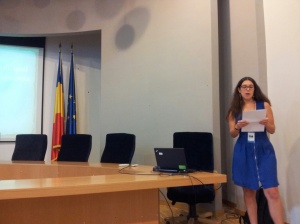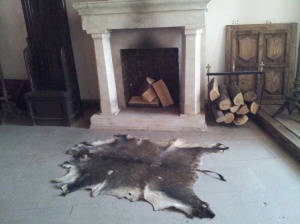‘We are in Transylvania; and Transylvania is not England, our ways are not your ways and there shall be to you many strange things’ (Bram Stoker)
I was beyond excited to find myself in Transylvania recently, fully expecting a gothic adventure. If I did not fall foul of a plague of vampires I at least expected to be besieged by ravaging wolves. The purpose of my trip was to dispel such dark imaginings however as Kaja and I were in Romania for the ‘Beliefs and Behaviours in Education and Culture’ Conference at the University of Timisoara (25th-27th June). Our panel was called ‘Where’s the place of Dracula, Deconstructing Stereotypes’. The title of my paper was ‘Spirited Away: The Representation of Transylvania in the Pied Piper and Dracula Myth in England and Germany, 1818-1922’ and Kaja (pictured below) presented on ‘Dracula: The big bad wolf and the myth of Gothic Transylvania’.
The agenda behind the literary part of the conference was largely to lay bare the process of othering in Gothic texts and expose the mythologising of Transylvania. Whilst Prof. William Hughes spoke insightfully about the ‘mythicized author’ in Bram Stoker, arguing that writers as well as places are subject to mythologising, Dr Duncan Light led the field in criticising the writer for creating negative stereotypes of Romania. He went on to claim that such images have subsequently fed into and informed racist perceptions of Romanian people in the British media. (I did begin to wonder at this point whether stories about Ceausescu and the plight of Romanian orphans were not more influential on the tabloid press). The idea of negative stereotyping perpetuated by Gothic fiction was further developed in Prof. Badin’s paper on the representation of Italy in nineteenth-century Irish Gothic Romances and in Dr Marius Mircea Crisan’s talk on ‘Deconstructing the Transylvanian Stereotype’.
I think it would be fair to say that there was a noticeable hostility to British and Irish Gothic fictions in light of this! As the conference progressed I began to have a slight quibble about the lack of specific attention to Gothic conventions and to ambiguity and contradiction. There is a deliberate mythologising in Stoker, one which is characteristic of all gothic writing. In Gothic we might typically find for example, ‘the legacies of the past and its burdens on the present, the radically provisional or divided nature of the self, the construction of peoples or individuals as monstrous or ‘other’, the preoccupation with bodies that are modified, grotesque or diseased’ (Contemporary Gothic, p. 8 ). Gothic itself as Catherine Spooner usefully surmises ‘did not emerge ready made and ripe for exploitation into the modern era, it has a history, over which it has changed, developed and accrued multiple layers of meaning. Gothic as a genre is profoundly concerned with the past, conveyed through both historical settings and narrative interruptions of the past into the present […] it is also however, profoundly concerned with its own past, self referentially dependent on traces of other stories, familiar images and narrative structures, intertextual allusions […] gothic has a greater degree of self-consciousness about its nature, cannibalistically consuming the dead body of its own tradition’ (Contemporary Gothic, p. 10).
It is useful to return to such definitions when analysing Stoker who does perhaps mark the beginnings of this process . A dependence on traces of other stories, intertextual allusions, and unashamed cannibalism, can shed light on Stoker’s uncritical use of sources (Emily Gerard on Transylvania and Sabine Baring-Gould on werewolves). More importantly, it suggests that any analysis of Stoker’s Transylvania must be very open to the pleasures of the text and the role of the reader.
There is of course much scope for wider discussion here and I would like to thank all of the speakers for inspiring such debates. Special thanks go to our kind host Marius Crisan who welcomed us to Timisoara and enthusiastically imparted his deep knowledge of Transylvania and its people during our visit. Marius is the author of The Birth of the Dracula Myth: Bram Stoker’s Transylvania (2013), which comes with recommendations from Prof. Carol Senf and Prof. Elizabeth Miller. This work was kindly gifted to the University of Hertfordshire on our visit.
Conversely, I learnt that Gothic Transylvania still exists if you go looking for it as our trip to Castle Hunedoara showed…
Imagining running down medieval corridors dressed in white muslin is not difficult if you are steeped in gothic conventions (and when faced with such architecture) and I make no apology for my gothic daydreams here…
We were thwarted in our search for wolves however and though we may have caught a glimpse of something lupine lurking in the undergrowth the only wolves we actually encountered were skinned or made into trophies (ironically this was rather gothic)
Whilst we didn’t stumble across any werewolves or encounter Dracula in wolf form we did see many references to Romania’s fascination with wolves such as this stunning She-wolf depicting the legend of Romulus and Remus in the centre of Timisoara…..
On leaving I found this little fellow in a shop window. He seemed to mock the very idea of my rational re-education….and to show again the past intruding on the present….how delightfully gothic!







